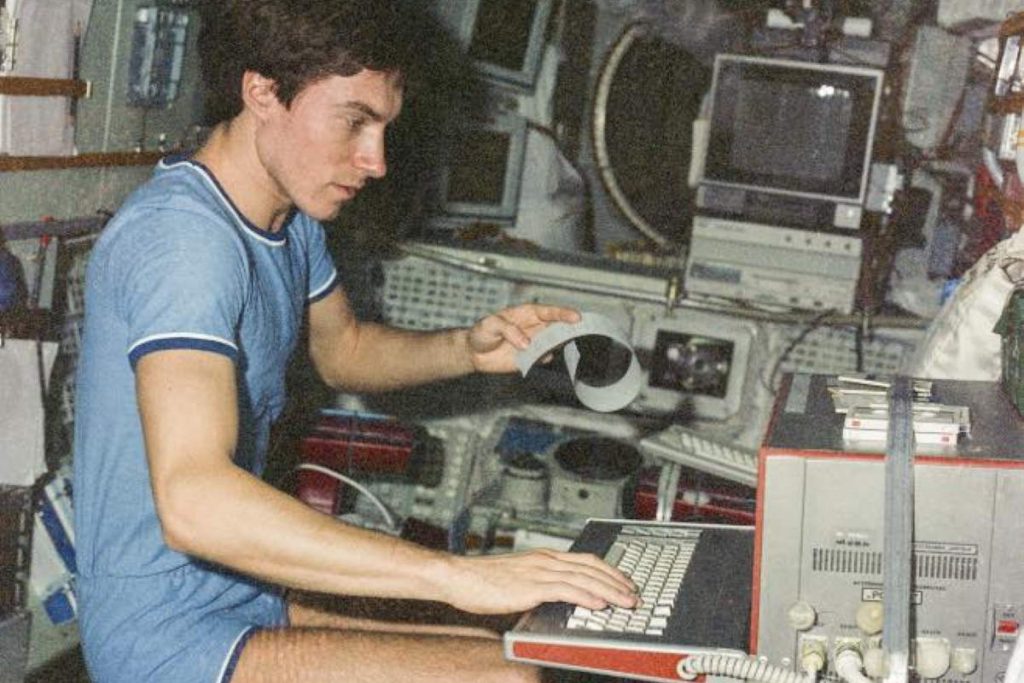Mir Space Station that operated in low Earth orbit from 1986 to 2001 became a legend in its own time reflecting Russia’s past space glories and her future as a leader in space.
The Russian Space Station Mir endured 15 years in orbit, three times its planned lifetime. It outlasted the Soviet Union that launched it into space. It hosted scores of crew members and international visitors. It raised the first crop of wheat to be grown from seed to seed in outer space. It was the scene of joyous reunions, feats of courage, moments of panic, and months of grim determination. It suffered dangerous fires, a nearly catastrophic collision, and darkened periods of out-of-control tumbling.
Mir soared as a symbol of Russia’s past space glories and her potential future as a leader in space. It served as the stage (history’s highest stage) for the first large-scale, technical partnership between Russia and the United States after a half-century of mutual antagonism.
Mir did all of that and like most legends was controversial and paradoxical. At different times and by different people, Mir was called both “venerable” and “derelict.” It was also “robust,” “accident-prone,” and “a marvel,” as well as “a lemon.”
For Russians, the very name “Mir” held meaning, feeling, and history. Mir translates into English as “world,” “peace,” and “village,” but a single-word translation misses its full significance. Historically, after the Edict of Emancipation in 1861, the word “mir” referred to a Russian peasant community that owned its own land. A system of state-owned collective farms replaced the mir after the Russian revolution of 1917.
As with most legends, Mir was literally beyond the reach of most men and women, but it could be seen by many as a bright light arcing across the night sky. Mir undoubtedly provoked many thoughts around the globe about who we, as a human race, are, and where we are going.
The cosmonauts and astronauts who were fortunate enough to travel to Mir were always impressed by its appearance. Regardless, Mir remained difficult to describe. Someone once called Mir a 100-ton Tinker Toy, a term that recalled Mir’s construction.
Adding modules over the years, and then sometimes rearranging them, the Russians had built the strangest, biggest structure ever seen in outer space. Traveling at an average speed of 17,885 mph (28,783 km/h), the space station orbited about 250 miles (400 km) above the Earth. Mir was both great and graceful -and incongruous and awkward- all at the same time.
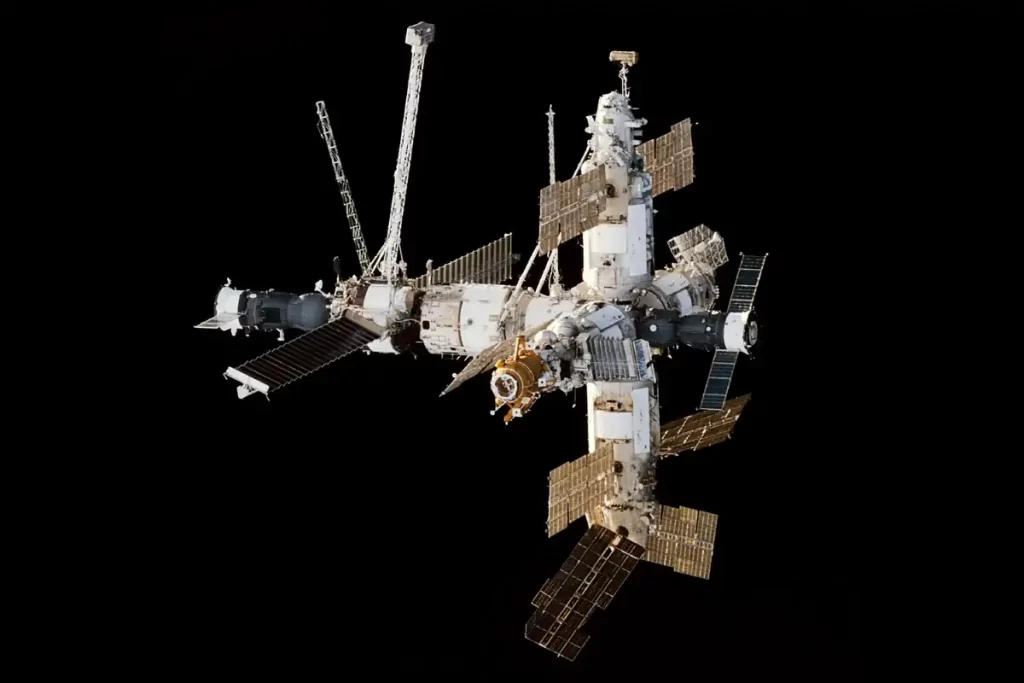
In outward appearance, Mir has also been compared to a dragonfly with its wings outstretched, and to a hedgehog whose spines could pierce a spacewalker’s suit. NASA-4 Mir Astronaut Jerry Linenger compared Mir to:
“…six school buses all hooked together. It was as if four of the buses were driven into a four-way intersection at the same time. They collided and became attached. All at right angles to each other, these four buses made up the four Mir science modules…. Priroda and Spektr were relatively new additions… and looked it – each sporting shiny gold foil, bleached-white solar blankets, and unmarred thruster pods. Kvant-2 and Kristall… showed their age. Solar blankets were yellowed… and looked as drab as a Moscow winter and were pockmarked with raggedy holes, the result of losing battles with micrometeorite and debris strikes over the years.”
On the inside, Mir often surprised people, too, even when they thought they were ready for the view. By the time Americans arrived on Mir -nearly a decade into its life- the station had become cluttered with used-up and broken equipment and floating bags of trash. During Mir’s lifetime, no adequate remedy was ever developed to deal with the stowage situation. Mir looked like a metal rabbit warren, or, as Mike Foale put it, “a bit like a frat house, but more organized and better looked after.”
Still, Mir was home and shelter to its crews, and how it looked to them depended on their perspectives and situations. The ivory-like controls of the Base Block reminded David Wolf of classic science-fiction stories, such as The Time Machine, by H.G. Wells.
After a fly-around in the cramped Soyuz capsule, Jerry Linenger wrote: “Looking into the station I could see a lone ray of light shining through the port widow and outlining the dining table. We had left some food out for dinner. It was the only time during my stay in space that Mir looked warm, inviting, and spacious. It reminded me of opening the door to a summer cottage that had been boarded up for the winter, looking inside, and seeing familiar surroundings.”
Mir set every record in long-duration spaceflight. Physician Valeri Polyakov lived aboard Mir for a single, continuous-orbit stay of 437 days, 17 hours, and 38 minutes. He completed his stay in 1995 as American Norm Thagard began his Mir residency. Polyakov’s experiences contributed greatly to the biomedical studies of long-term human spaceflight conducted by the Institute of Biomedical Problems, where he served as Deputy Director.
Combined with an earlier Mir expedition flight, the Russian cosmonaut spent a total of 678 days, 16 hours, and 33 minutes on the Russian space station. However, his achievement for total time in space was surpassed in 1999 by Sergei Avdeyev who endured a total of 747 days, 14 hours and 12 minutes, during three space missions. During Shuttle-Mir, Shannon Lucid set the space endurance record for women in 1996 when she spent 188 days, 4 hours, and 00 minutes in orbit.
“Just as the word ‘Mir’ held multiple meanings for Russians, Mir—the space station—evoked a wide range of emotions. In February 1995, Russian cosmonaut Vladimir Titov participated in the ‘near Mir’ mission, STS-63, when the Space Shuttle rendezvoused with the Mir station.
Six years earlier, Titov had spent a year aboard Mir as an expedition member, when Mir consisted of only the Base Block, the two Kvant modules, a Soyuz, and a Progress spacecraft. About seeing Mir again, Titov said, “It was very wonderful, a wonderful view.” STS-63 did not dock, but Titov visited Mir again as a crewmember of STS-86.
Alas, the sturdy Mir was built on a sinking foundation. Without repeated boostings, all things in low Earth orbit must eventually come down. With the new International Space Station requiring much of the Russian space program’s attention and financing, the Mir Space Station was doomed to be deorbited.
A strong effort rallied in Russia to keep Mir aloft; and at one point, Russian State Duma representatives were calling for the firing of Yuri Koptev from his post as the head of Russia’s aerospace agency. However, on December 30, 2000, Russian Prime Minister Mikhail Kasyanov signed a resolution calling for Mir to be sunk into the ocean, early in 2001.
Concerns circled the globe about Mir crashing into populated areas. Mir’s path crossed over nearly every city on Earth. Its orbits tracked over everything between 51 degrees North and South latitude, roughly within the limits of the Aleutian Islands to the north and the southern Andes Mountains to the south. Pieces of previous large spacecraft had landed in Canada, Australia, and southern South America, albeit fortunately without any damages or casualties.
For Mir, Russia acquired insurance in the event that its deorbit caused some physical damage. Japan kept a close watch because the final orbit would bring the Mir over the island nation. The U.S. government provided Russia with tracking and trajectory data, atmospheric conditions, and even solar activity, which can cause the Earth’s atmosphere to expand farther into space. Although there was considerable certainty that debris could be limited to falling in the ocean, Yuri Semenov, RSC Energia President, was quoted as saying, “We don’t have a 100-percent safety guarantee.”
After more than 86,000 total orbits, Mir re-entered Earth’s atmosphere on Friday, March 23, 2001, at 9 a.m. Moscow time. The 134-ton space structure broke up over the southern Pacific Ocean. Some of its larger pieces blazed harmlessly into the sea, about 1,800 miles east of New Zealand. Observers in Fiji reported spectacular gold- and white-streaming lights. An amazing saga and a highly successful program finally came to a watery end.
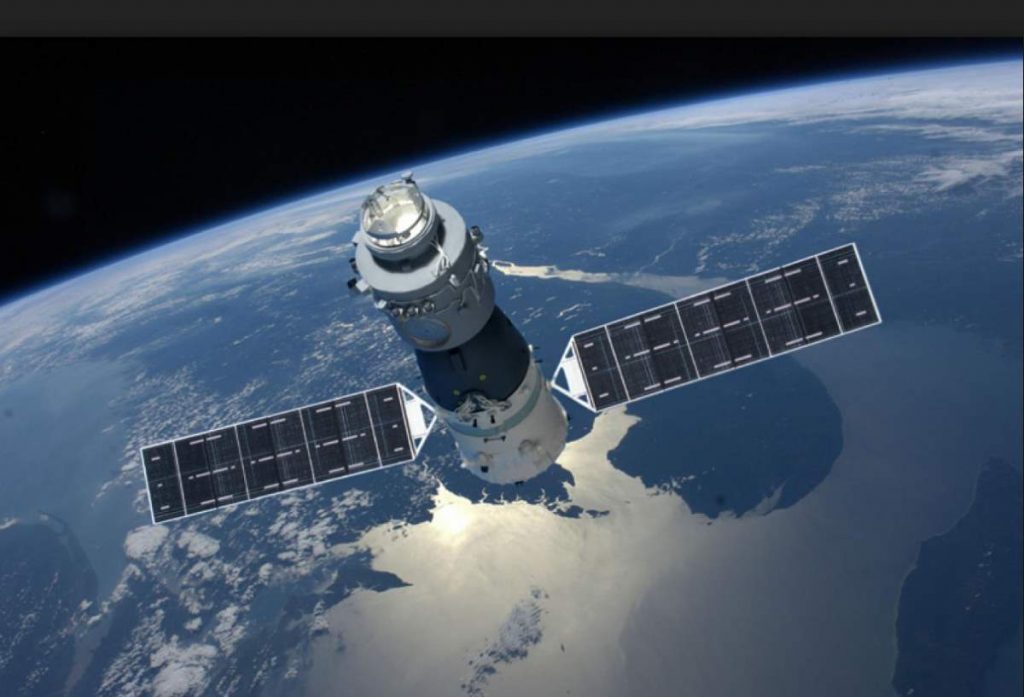
Related: What Happens to Old Spacecraft?
Anatoly Solovyev had lived a total of 651 days on Mir and served as Mir-24 commander for Americans Mike Foale and David Wolf. He was quoted in Star City as saying, “I am especially sad these days. An entire era of our Soviet space program is ending, into which we invested not only our money but, what is more important, our intellectual potential.”
The Russians’ investment began when a Soviet Proton launcher boosted Mir’s Base Block (core module) into orbit on February 20, 1986. This module resembled the existing Salyut-7 space station, but Mir’s design called for expansion through the addition of future modules.
Mir’s first crew arrived in mid-March 1986, and the inaugural crew of Leonid Kizim and Vladimir Solovyev stayed aboard until May 5, 1986. This Solovyev would later become the Russian co-chair of the Flight Operations Working Group for the Shuttle-Mir Program. And it was he who took charge of the Moscow Mission Control Center immediately after the Progress resupply vehicle collided with Mir, during NASA-5 Mir Astronaut Mike Foale’s residency.
In 1987, the Soviets added Mir’s first expansion module, Kvant-1, and had the world’s first modular space station. They still needed a more versatile way of transporting crews and equipment to and from Mir – something like the American Space Shuttle.
In 1988, the Soviets launched the Buran, a winged, reusable space vehicle and a close copy of the U.S. Shuttle. Its first flight was near perfect. However, at this point in history, the Soviet Union was crumbling. No further Buran flights were attempted; four planned orbiters remained unfinished.
The Soyuz-TM vehicle and Progress-M resupply (cargo) vehicle became the transports of crews and supplies to the Mir. The Kvant-1 featured a docking port to accommodate the arrival of these spacecraft. The system worked well as the Russian space station was unoccupied on only five brief occasions until its deorbit on March 23, 2001. During its existence, the station had remained almost continuously occupied for nine years.
Mir continued to expand during the next years with the additions of modules for research and residence. Kvant-2 arrived in November 1989 with an airlock that allowed crewmembers access to the outside of the complex for extravehicular activities. Kristall, launched at the end of May 1990, housed Earth observation instruments and was used for semiconductor and biological experiments. Five years later, Spektr, a remote-sensing module for geophysical sciences, was added to the Mir.
On June 29, 1995, U.S. Space Shuttles began docking with the Russian space station. Before this first docking, the Mir-19 crew used the Lyappa manipulator arm to relocate the Kristall, thus allowing ample clearance for Atlantis. In November 1995, a new docking module arrived via STS-74 and was attached to the Kristall to provide means for future dockings without interference. The next year, on April 23, 1996, the final module, the Priroda, was added to the Mir.
The complex retained a docked Soyuz-TM vehicle at all times as this spacecraft served as the crew’s “lifeboat.” The vehicle carried a maximum of three persons, took two to three days to reach its destination, and could remain docked with the Mir for approximately 200 days before its orbital lifetime limit expired.
The resident Soyuz was used for an occasional, scheduled “fly-around” of the T-shaped Mir, but crews primarily ventured outside for extravehicular activities (EVAs). During Mir’s lifetime, crewmembers spent more than 325 hours as part of 75 planned spacewalks to conduct research and repairs on the exterior of the structure. Additional hours were spent during three intravehicular walks inside the unpressurized Spektr module.
Participants in the Mir EVAs included 29 Russian cosmonauts, 3 U.S. astronauts, 2 French astronauts, and 1 European Space Agency astronaut who was a citizen of Germany. Cosmonaut Anatoly Solovyev donned the Russian Orlan spacesuit for 16 spacewalks for a total time of 77 hours, 46 minutes more EVA time than any other spacewalker in the world.
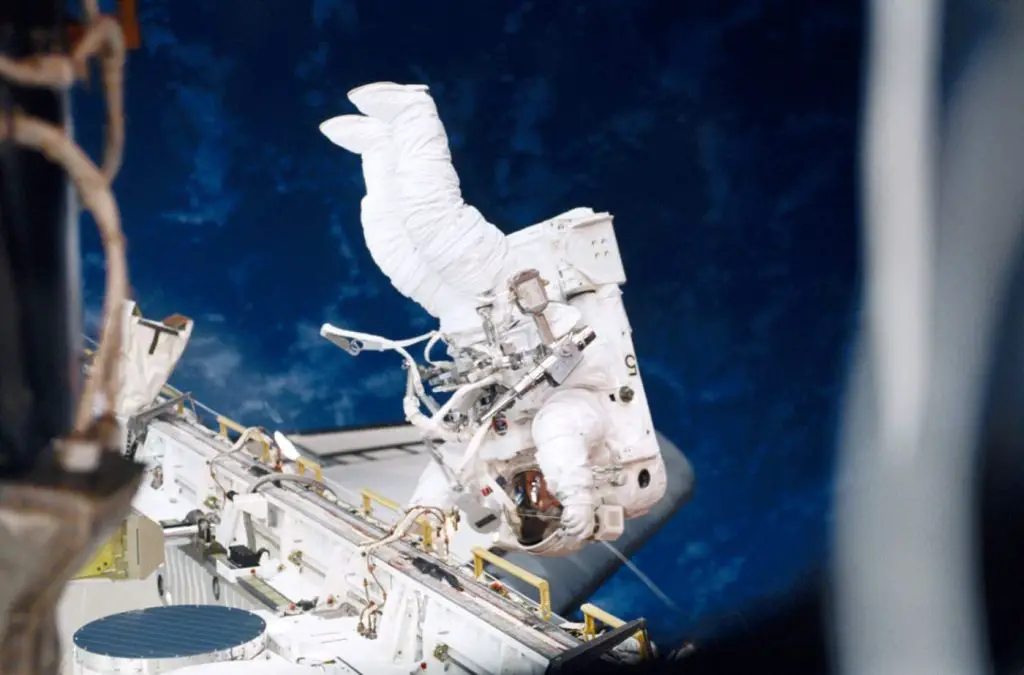
Related: Top 20 Longest Spacewalks in History
After the Russian space station moved into its second decade, the Mir became notorious as an accident-prone spacecraft, even as it remained unparalleled in continuous service. A 15-minute fire in an oxygen-generating device imperiled the station in February 1997.
Failures of the Elektron electrolysis oxygen-generating units and problems with attitude and environmental controls often seemed to alternate with computer malfunctions and power outages. The June 1997 collision with the Progress supply vehicle breached the integrity of the Spektr’s hull and rendered that module uninhabitable.
But, Mir remained, and its space explorers endured. Over its lifetime, the space station hosted 125 cosmonauts and astronauts from 12 different nations. It supported 17 space expeditions, including 28 long-term crews.
Its residents arrived via the 31 spacecraft that docked with Mir; nine of the dockings involved the Space Shuttle. Additionally, 64 uncrewed cargo vessels ferried supplies and equipment periodically to Mir. And, it served as a floating laboratory for 23,000 scientific and medical experiments.
Although Mir was gone by early 2001 and the International Space Station (ISS) was growing rapidly in orbit, the U.S. and Russia were still using spacecraft as statecraft.
On March 23-the same day as Mir’s deorbit – Russia expelled four U.S. diplomats and said it would expel 46 more, in retaliation for the American expulsion of 50 Russian diplomats for espionage-like activities. It wasn’t the Cold War, all over again, but international tensions were certainly continuing, and the need remained for a worthy program for U.S. and Russian cooperation.
One could still apply to the ISS the same hopes that Shuttle Commander Charlie Precourt had held for it during Shuttle-Mir. Precourt had predicted that the ISS would “…provide the psychological impetus for politicians to force themselves to find an agreement to disputes that otherwise they wouldn’t – because they’ll all look up there and say, ‘Well, we have an investment in that, too. We have to keep this relationship going in a proper direction.'”
Although the U.S.-Russian relationship was still going in the “proper direction,” toward continued cooperation in space, the proper use and the funding of ISS were still in question. NASA cost overruns for the ISS clouded the program’s future, and Russia’s foreign department was threatening to reduce its participation in the ISS. To make the situation even more complicated, the ISS partner nations were discussing whether Russia should launch a wealthy, American “space tourist” to the space station.
Notwithstanding all the diplomatic wrangling, Mir’s demise also coincided neatly with the successful finish of the first U.S.-Russian expedition to the ISS. On March 22, 2001, Expedition One crewmembers Sergei Krikalev, Yuri Gidzenko, and Commander William Shepherd returned to the Johnson Space Center in Houston. They received a ride from STS-102 Shuttle Commander James Wetherbee and a crew that included former Mir resident Andy Thomas. STS-102 had ferried the Expedition Two crew of James Voss, Susan Helms, and Commander Yury Usachev to the station.
Just as the ISS itself grew out of the lessons of Mir, many of the principal people in the ISS Program drew from their experiences during the Shuttle-Mir Program. And, in Houston and in Moscow, American and Russian managers, engineers, and technicians who had worked in the Shuttle-Mir Program were working to make the ISS a success.
The International Space Station was growing, but the memories of Mir refused to fade. Indeed, people had anticipated its demise for long enough that, even before it fell, it had entered nostalgia.
In a 1998 interview, Vladimir Semyachkin reflected on Mir. He developed the motion control systems and navigation systems for all vehicles and stations that were produced and launched into space by RSC Energia. Semyachkin, as much as anyone, had wrestled with Mir’s problems. He said:
“It’s a shame…. Our child, who we gave birth to so many years ago,… we’re going to have to put it to sleep. But, on the other hand, we understand that sometimes there’s nothing to be done…. One cannot sit, as it were, on two chairs at the same time. Nevertheless, despite this sorrow with… regard to Mir, we nonetheless do look forward to the future with a great deal of hope.”
Video: Inside Mir Space Station
Mir Space Station Modules
1. Mir Base Block (Core Module)

The Mir Base Block (core module) evolved from the earlier Soviet Salyut to serve as the heart of the space station. Launched in February 1986, the 13.1-meter-long (43 feet), 20.4-metric ton core contained the primary living and working area, life support, and power, as well as the main computer, communications, and control equipment-all in 90 cubic meters of habitable volume.
Mir’s environment was generally maintained at temperatures of 64°F to 82°F (17.78°C to 27.78°C) and humidity of 20 to 70 percent. The core had four main compartments.
The Working Compartment was actually two cylinders connected by a conical section. It provided operations and living areas. Operations included monitoring, command, and scientific activities.
The living area provided the necessities for long-duration missions, including a galley with a table, cooking elements, and trash storage; a bicycle exerciser and treadmill with medical monitoring equipment; video equipment; and individual crew areas, each with a porthole, hinged chair, and sleeping bag.
The personal hygiene area, with toilet and sink, was located at one end of the working compartment. Mir had several portholes, with shutters outside to protect them from orbital debris impacts. Two television screens permitted face-to-face communication with the ground. Four more television screens monitored the other Mir modules.
The Transfer Compartment was a spherical structure at the front end of Mir, providing one end-docking port for visiting spacecraft, plus four radial berthing ports, set in a 90-degree arrangement, for access to the station’s added modules.
An approaching module used the Kurs (course) automatic docking system to dock with the forward port. Crews could then use the module’s manipulator arm system to move it to a radial port, thus freeing the forward port for future use. The Transfer Compartment had no simulated “up and down” indicators; it was an area of Mir where astronauts reported sensations of disorientation.
The nonpressurized Assembly Compartment, on the other end of the Base Block, contained the station’s main engine and fuel tanks; it supported antennas, lights, and optical sensors. The pressurized Intermediate Compartment tunneled through the Assembly Compartment to connect the Working Compartment to the aft docking port, where the Kvant-1 module was permanently docked.
2. Kvant-1 (Astrophysics Module)
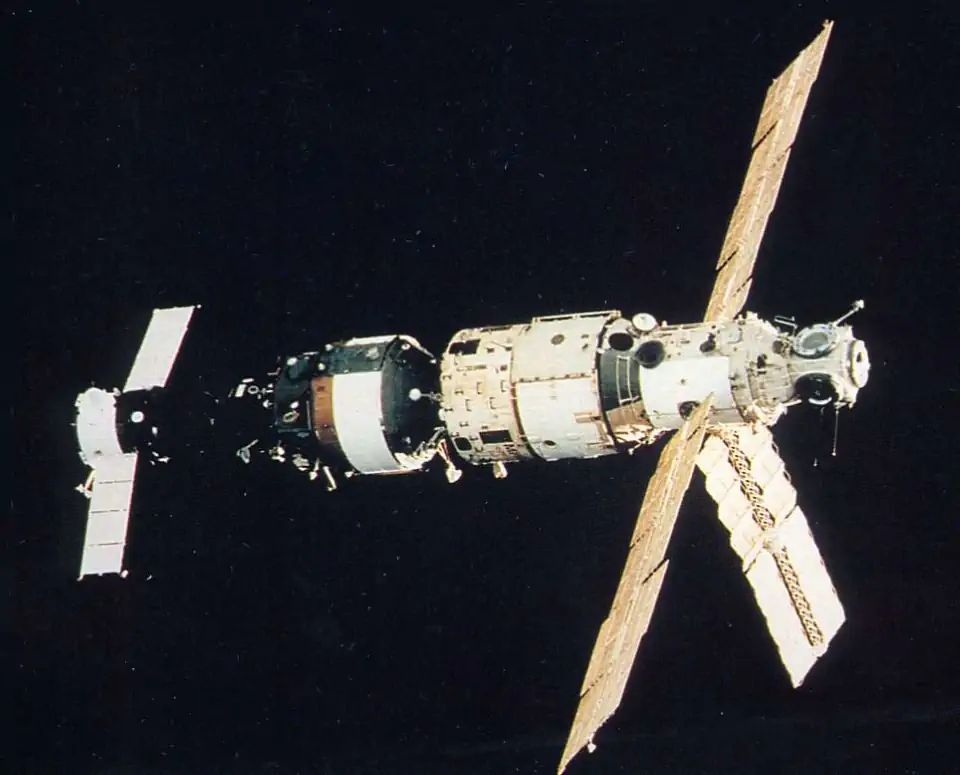
Kvant means “quantum.” When Kvant-1 was docked permanently to Mir’s aft docking port in April 1987, it increased Mir’s usable volume and expanded its scientific capabilities. Kvant-1 supported research in the physics of galaxies, quasars, and neutron stars by measuring electromagnetic emissions.
The module also supported biotechnology experiments and had some station control and life support functions. The 11-metric ton Kvant-1 measured 4.4 meters (14.5 feet) by 6.3 meters (20.6 feet) long, with 40 cubic meters of pressurized volume.
The module was equipped with six gyrodynes that provided accurate pointing of the station and significantly reduced the amount of fuel used for attitude control. Its aft docking port was available for Soyuz and Progress vehicles.
3. Kvant-2 (Augmentation Module)
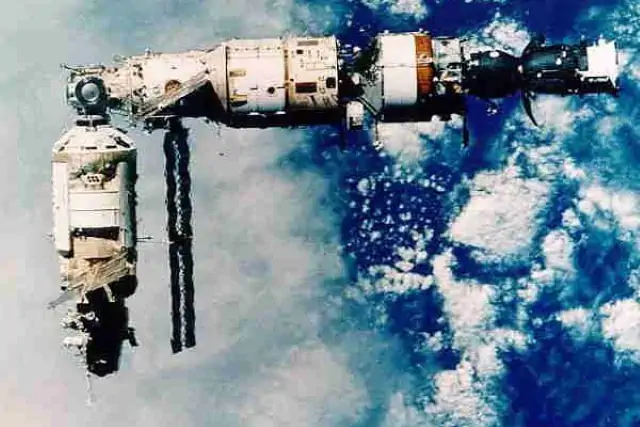
Kvant-2 was a scientific and airlock module, provided biological research, Earth observations, and extravehicular activity capabilities.
The Kvant-2 enhanced Mir with drinking water and oxygen provisions, motion control systems, and power distribution, as well as shower and washing facilities.
Its airlock contained a self-sustained cosmonaut maneuvering unit that increased the range and complexity of extravehicular activity tasks. The 19.6-metric ton Kvant-2 measured 4.4 meters (14.5 feet) by 13.7 meters (45 feet) long with 61.3 cubic meters of volume and 27.4 meters (90 feet) of solar arrays.
It was the first module equipped with the Lyappa manipulator arm, used to move the modules after they docked with Mir. The Kvant-2 docked with Mir in November 1989.
4. Kristall (Technology Module)
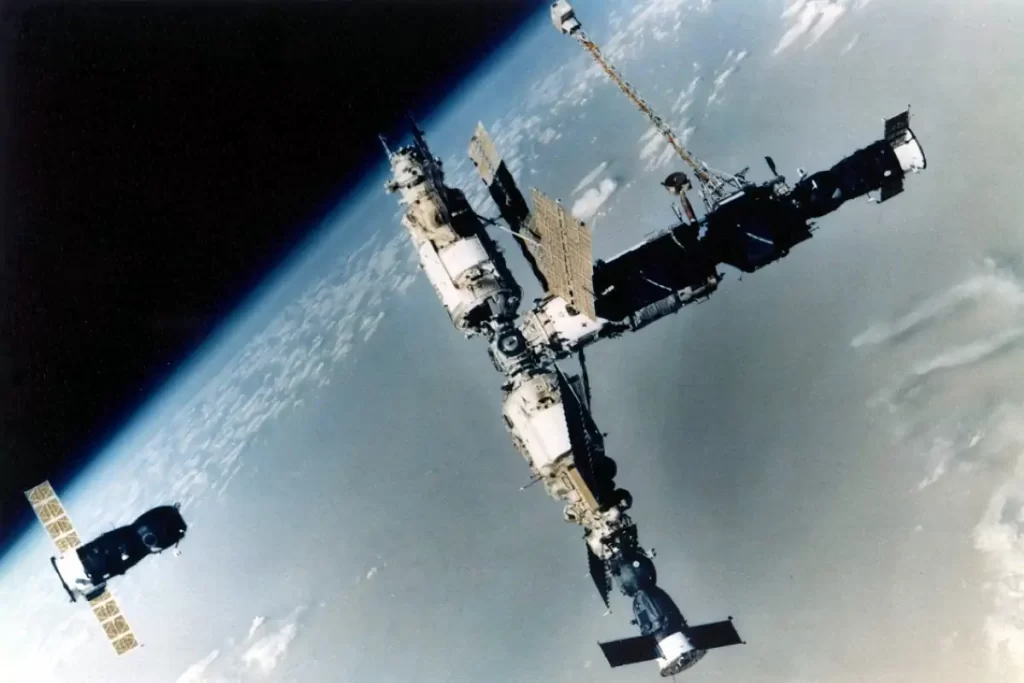
Kristall means, you guessed it, “crystal.” This module supported biological and materials production technologies in the microgravity environment. These included semiconductors, cellular substances, and medicines. Kristall also supported astrophysical and technical experiments.
It had a radial docking port, originally designed as a means of docking the Russian Shuttle-type orbiter Buran, and was used for the first STS-71 docking in 1995. Added in June 1990, the 19.6-metric ton Kristall measured 4.4 meters (14.5 feet) by 13 meters (43 feet) long, with 60.8 cubic meters of volume and 36 meters (118 feet) of solar arrays.
5. Spektr (Power Module)
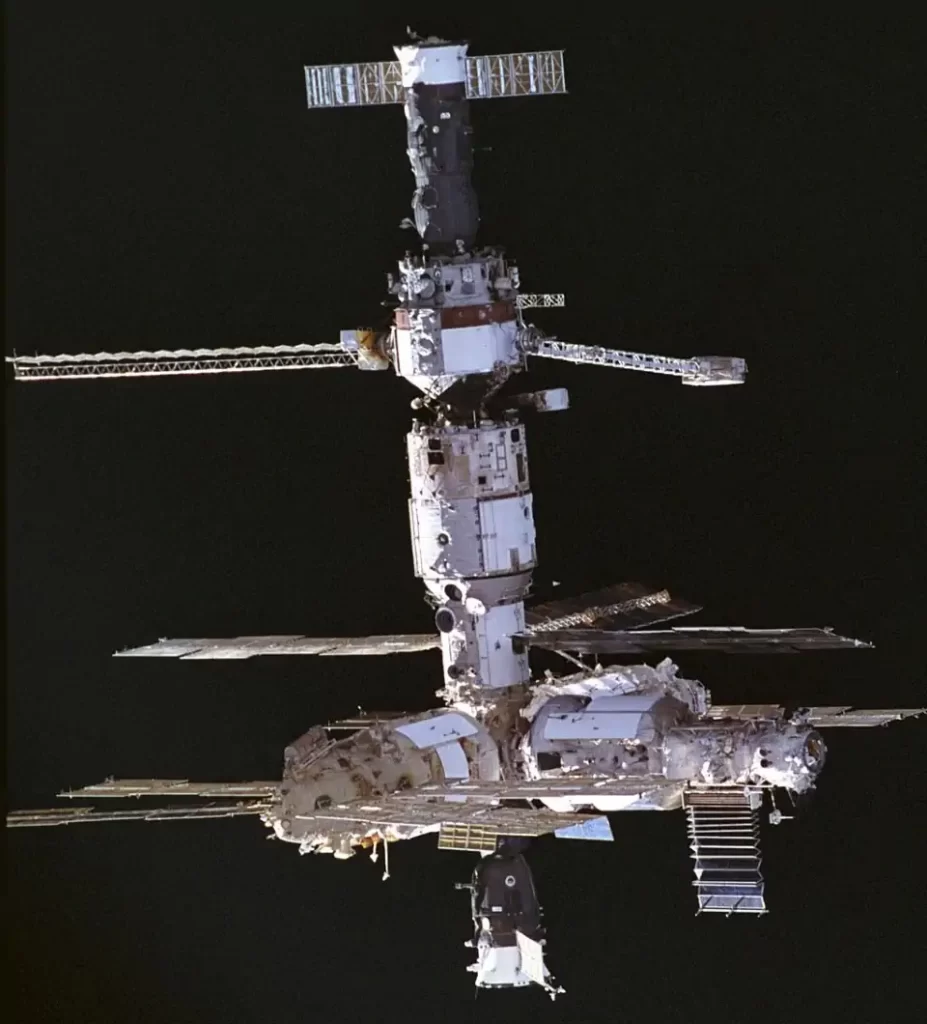
Spektr means “spectrum,” and this module allowed for better investigations and monitoring of Earth’s natural resources and atmosphere. Spektr also supported research into biotechnology, life sciences, materials science, and space technologies.
American astronauts sometimes used Spektr as their living quarters. Launched in May 1995 during Norm Thagard’s mission to Mir, Spektr carried more than 1,600 pounds (725 kg) of U.S. equipment, mainly for biomedical research. Included with its arrival were two pairs of solar arrays to boost power to the station and a Lyappa manipulator arm to assist in moving the modules on Mir.
The 19.3-metric ton Spektr module measured 14.4 meters (47 feet) by 4.4 meters (14.5 feet), with a pressurized volume of 62 cubic meters, and had four solar arrays.
On June 25, 1997, an uncrewed Progress resupply vehicle collided with the Spektr module, causing solar array and hull damage, and depressurization. The Mir crew closed the hatch to the leaking Spektr, preventing further pressure loss onboard Mir.
6. Priroda (Earth Sensing Module)
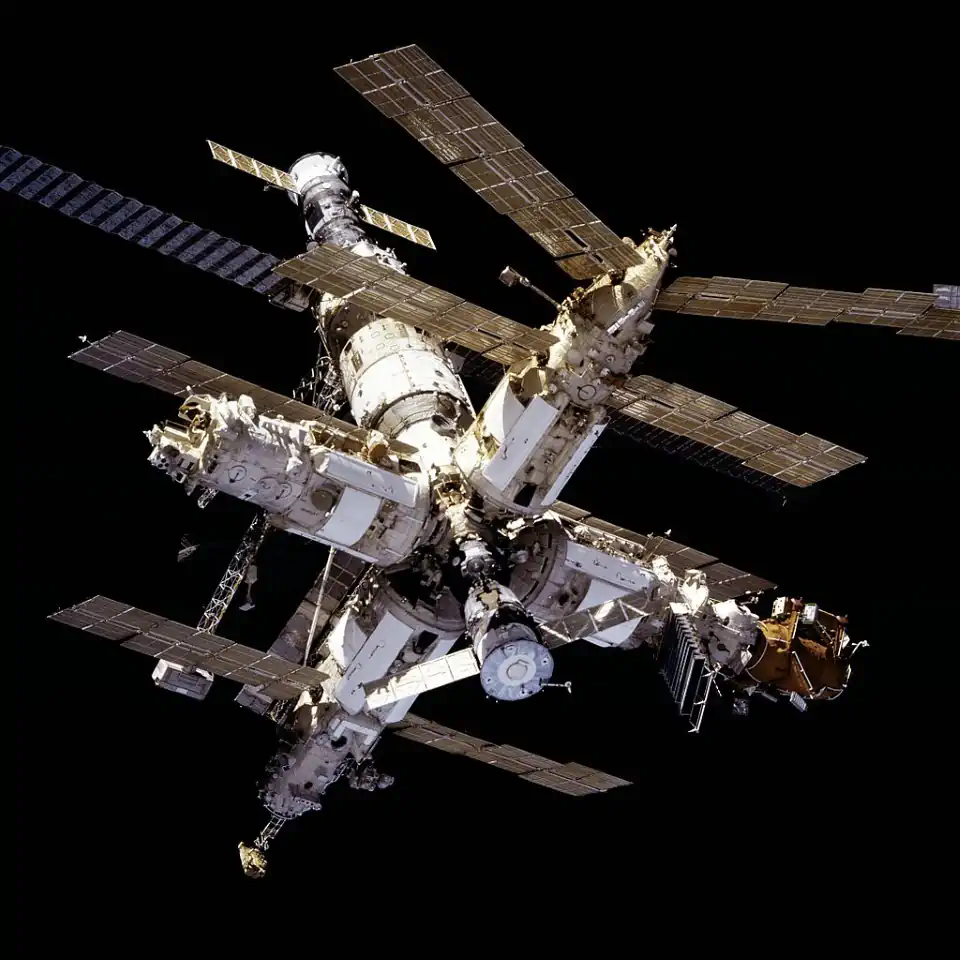
Priroda means “nature,” and this module’s main purpose was Earth remote-sensing including the weather; the ocean-atmosphere system; land, mineral, and crop conditions; and humankind’s impacts and opportunities in the environment.
Priroda also collected information from remote-sensor buoys in nuclear power, seismic activity, and other areas to create an integrated monitoring and warning system. Launched in April 1996, Priroda, the last of the Mir modules arrived during Shannon Lucid’s stay on the Mir Space Station.
The 19.7-metric ton Priroda measured 4.4 meters (14.5 feet) by 12 meters (39 feet) long and had a pressurized volume of 66 cubic meters.
7. Docking Module
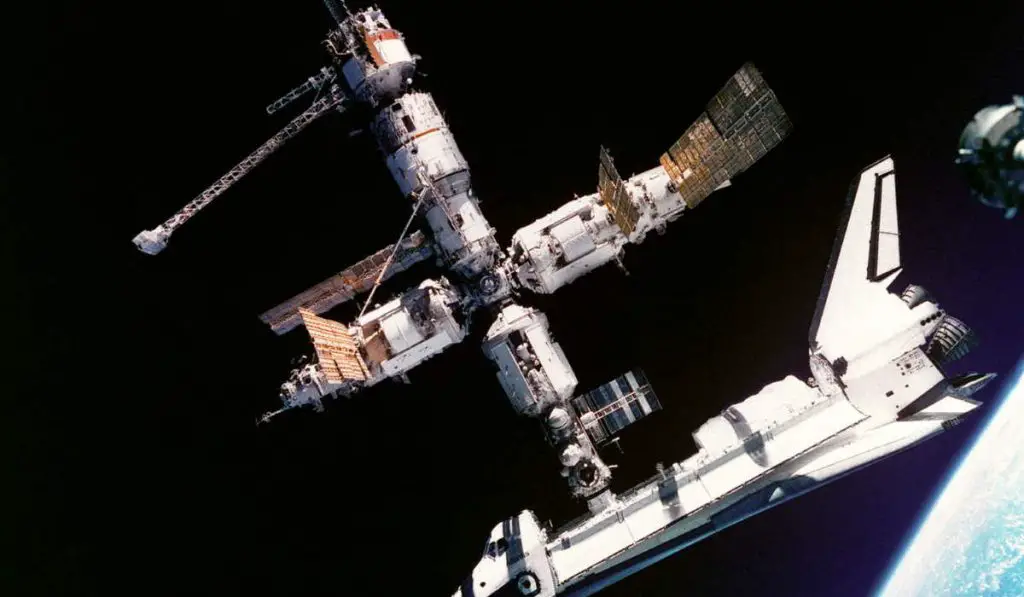
The Russian-built Docking Module of the Mir Space Station was delivered by STS-74 on November 14, 1995. Attached to the Kristall, the Docking Module (DM) provided clearance for the Shuttle to dock easily with Mir without interference from the station’s solar panels.
The DM featured a pressure-sealed body and an androgynous peripheral docking system (APDS), compatible with the Kristall and Shuttle Orbiter docking systems (ODS). The Shuttle ODS, an external airlock extension, was fitted to the forward payload bay bulkhead and was accessible by the crew via the mid-deck airlock. When docked, the APDS provided locking, structural stiffness, and an airtight seal between the two structures.
The DM was 4.7 meters (15.4 feet) long from tip to tip of the identical APDSs on either end; its diameter was 2.2 meters (7.2 feet); and weighed approximately 4.1 metric tons. The module carried to the Mir two solar arrays: one Russian and one jointly developed by the U.S. and Russia to augment Mir’s power supply. The DM carried the arrays retracted and stowed to be later deployed by cosmonauts.
Progress Resupply Vehicle
The uncrewed, automated Progress was derived from the Soyuz crew transfer vehicle. It was designed to resupply and refuel the Russian Salyut and Mir Space Stations. A Progress typically approached and docked automatically at Mir’s aft docking port, using the Kurs (course) system. During Shuttle-Mir, Progress vehicles supplied Mir about once every two months. They are also used for the International Space Station.
Like the Soyuz, the Progress freighter measured about 7 meters (23 feet) long by 2.7 meters (8.85 feet) wide. It had 6.6 cubic meters of volume and carried about 2,400 kg (5,300 lbs) of cargo. The refueling compartment of the Progress was replaced with a nonpressurized cargo compartment to enable the transport of materials to be used on the outside of Mir.
Progress was also designed to carry small satellites, which could be released by the Mir crews. After being loaded with trash, waste, and other unnecessary items, a Progress undocked and deorbited, to burn up upon re-entry over the Pacific Ocean.
Early in the Soviet space station program, crews always got into their Soyuz descent vehicles as a manually guided Progress approached, in case of an accident. The practice was discontinued after many successes and increased confidence.
Solar Arrays
Electrical power in spacecraft can be produced in many ways; for example from batteries, or by nuclear and chemical fuel cells, or by solar cell arrays. Solar panels provided most of the power on Mir, and the station sometimes appeared as if it were “more panel than a module.”
Nevertheless, as one Russian engineer put it, “We never managed to get rid of our energy hunger.” Whenever the station lost attitude control, due to computer or gyrodyne failures, restoring solar power generation was usually the main concern, because almost all the other systems ultimately depended on it.
Notes
- Mir (Russian: Мир, IPA: [ˈmʲir]) literally means ”peace” or “world”. However, a single-word translation misses its full significance. Read by Frank Culbertson, Shuttle-Mir Program Manager, titled “Mir: What’s in a Name?” In a nutshell, according to Culbertson, the name Mir means “community”.
Sources
- Mir Space Station on the NASA History website
- Mir on Wikipedia
- Moon Landings: All-Time List [1966-2025] - February 2, 2025
- What Is Max-Q and Why Is It Important During Rocket Launches? - January 16, 2025
- Top 10 Tallest Rockets Ever Launched [2025 Update] - January 16, 2025


